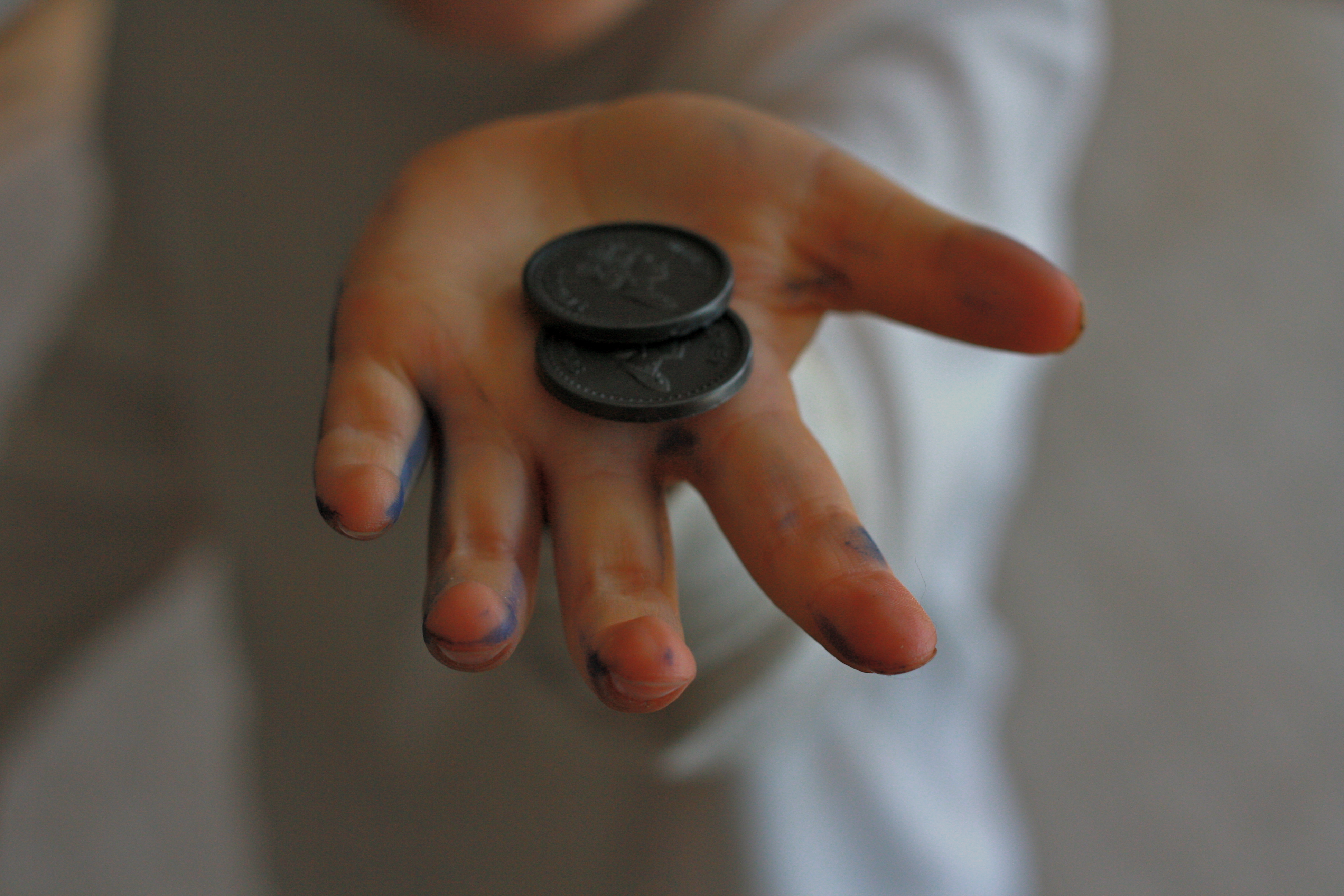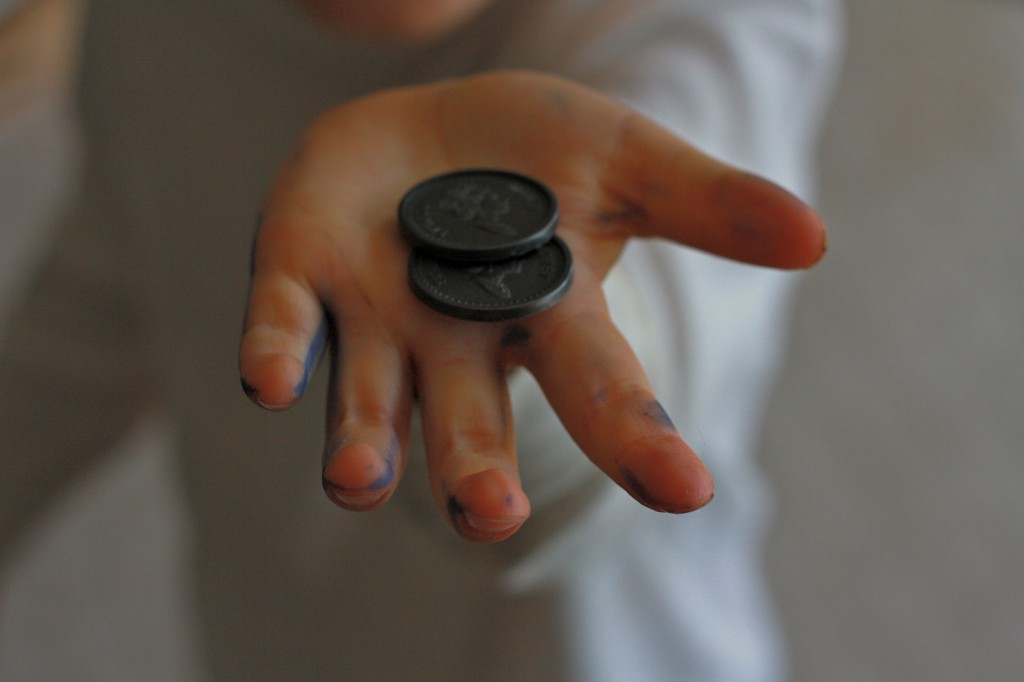Just recently my son, who is three and a half, discovered the weekly Canadian Tire flyer and within weeks followed it up by laying hands on the Sears wish book. He has since spent hours coveting every toy on every page. We didn’t bring the wish book home, rather, a friend offered to let him keep their copy because he was so interested in it. Since then he has spent hours looking at, and dreaming about, all the toys which he has never seen before. He lets us know that he wants each one and asks if we can buy it. Up until now, we have kept our children as far away from commercialism as we thought was reasonable, by choosing not to have TV, not buying disposable toys, and not being big spenders ourselves. I feel that we, relatively, live a non-commercialistic life and yet the pervasiveness of the industry has grasped hold of our son in a way we didn’t predict. We want our children to learn to be content with what they have, yet strive constantly to live life better. And the things that we buy and how we buy them are rarely neutral, they either help us live life better or get in the way of living well.
My mom tells a story about how when I was an elementary student I asked her the question “Are we poor?”. My Dad was a pharmacist and my mom was a nurse in rural BC and so relative to the bulk of the community we were anything but poor. Most people would have looked longingly at what my parents had achieved. I thought that we were poor because we didn’t have the stuff that many of my friends had such as quads, video games, cable television and a VCR. My mom told me that we could afford that stuff, if we wanted, but our family didn’t want that stuff. I couldn’t understand the concept as a child and I don’t expect my son to understand the similar notion now when he looks at the wish book. We can afford the toys that he so covetously desires but we don’t want them. In themselves, they wouldn’t destroy his good nature but at the same time they will not contribute to the life lessons that we want him to learn. His character development, would surely suffer if we bought everything he wanted.
I learned to be generous, although I am not near as generous as I should be, from parents who gave financially on a regular basis and from my first employer who lives a life of generosity, both in time and money, that I still aspire to match. Through the amazing friendships that I have, I found that the greatest joys come from relating to others and finding ways to relate to them in greater depths. As for contentment, I have to admit that it remains an elusive characteristic that I hope to attain. I am constantly in flux between being amazed with the blessings that have been poured out upon me and my family, and being discontent with what I still do not have. It remains a virtue in progress. Nonetheless it is a characteristic that I hope to pass on to my children even if I am never able to attain it.
So what does this have to do with public education? Nothing. And that is exactly the problem.
The curriculum in a public school is completely silent on the most important aspects of life. They don’t mention, let alone teach, among other things, how to be content, patient, generous, wise or just. The most important lessons of life are completely missing from the system. How can we teach about the atrocities and hate of war without telling them how necessary it is to love ones neighbour in a meaningful way? A life well lived isn’t about tolerance, and respect, it is about compassion and love. And how can we teach about current events and the inequitable state of finances on a world scale without demanding generosity? I know that many schools raise money to counter injustice around the world, and that it is good, but few if any teach that a student should practice giving to the less fortunate out of their own pockets, on a regular basis, not only when one is living in abundance, but throughout their life, starting immediately. Anybody who lives in Canada has something to contribute, even if it is simply writing letters, to the impoverished nations around the world. It is too bad that so many of us don’t realize this.
How can we teach about being content when so few of us are? We live in a society where more is better and what we have is never enough and those concepts are perpetuated by schools, where students are constantly judged by their peers for what they have (clothes, phones, ipods, games, friends) and don’t have. The school system has no answer for the malady of discontentment that plagues society. In fact, I don’t believe that the institution has even considered the possibility that the malady even exists. We see children being ostracized for lack of designer jeans and respond with an anti-bullying campaign. What is missing is humility on the part of the students who can afford the jeans, contentment on the part of the child who can’t, and an understanding of love for one’s neighbour that has the ability to overcome these differences. Most children do not grasps those concepts, neither do most adults, but I would prefer that my children learn somewhere that tries to communicate the complexity of the inequalities in the world and with someone that models a well lived life in the face of these complexities. In the face of bullying, schools respond with raising awareness, class meetings, and parental phone calls to find ways where all involved parties can co-exist and find a way to function within the same space.
Rather than demanding that everybody meets minimal standards like schools, we should strive for a learning environment that emulates love, patience, contentment, generosity, inner strength, and humility. See if you can find any of those life pillars in the government mandated learning outcomes, school rules, or class expectations. The place that comes closest to modelling and teaching such grand ideas is the family home and that is where I want my children to be taught.
And so back to my son, who has quickly developed a covetous trait which I find painfully similar to my own, who I fear will feel that we are poor when we are not, and who has so much to learn about life. We told him that we would not buy the toys for him but he is welcome to buy the toys himself with his own money. We counted his money together and he only had five dollars so we suggested that he does some work in order to make some more money. He could help with the recycling, and he did, and he made another five dollars. We then set aside fifty cents to give away to somebody less fortunate. He now has close to ten dollars and is looking for more ways to raise money so that he can earn one of the toys.
He didn’t argue when we told him that he had to give some of his earned money away. To him, it is just what everybody does. Generosity is a way of life. He now has enough money to buy a couple of toys in the wish book but hasn’t decided which one he will get yet. Personally I think that he will hold off until he has enough money to buy one of the big toys that really gets him excited.
The toy that he chooses is unlikely to have much impact on his character development but perhaps we can use the process in order to convey some of the aspects of life that contribute to a well lived life such as generosity, patience, hard work, and contentment. Aspects of life that should be taught and are best taught at home.
—
We’re linking up with Preschool Corner at Homeschool Creations.






Robin,
I think school is not just silent on consumerism, but it covertly teaches it,too. The underlying message kids get in schools is that it’s really important to buy things all the time. What happened a few years ago in the US? Obama gaves everyone an extra check to “help out with the recession” and encouraged everyone to go out and buy things to help the economy. There was no message to save that money or to pay off your debts with it. So, I’ve no doubt that the majority of the people who received an extra check from the government went out and bought something they really didn’t need. I’m glad that, like you, I can raise my kids every day to know that after a cetain point you really don’t need anything more than what you have. And if they spend their own money on the majority of new toys they get, they will have a better appreciation for what it takes to own those things.
Nice post. Oh, I am struggling with how and when to do allowance. I want to teach my daughter about money and how to earn it, but I also think chores are something the whole family does to help out with the house (no payment should be required). I am glad you have found something that works for your family.
Thanks, once again, Robin, for your thought-provoking perspective. We’ve just started to think about this, too, with our kids, and wondering what the best approach will be. I love that you are so conscious about what values you want to instill in your son. I also love that this post comes after the post-Christmas gluttony. So much food for thought.